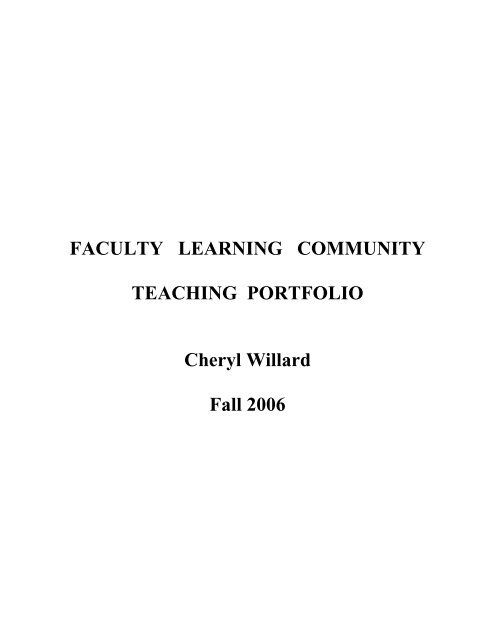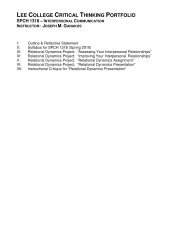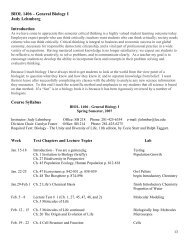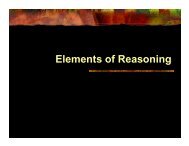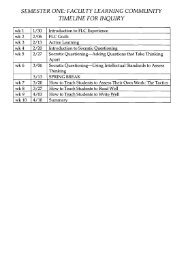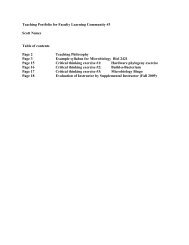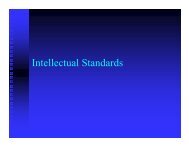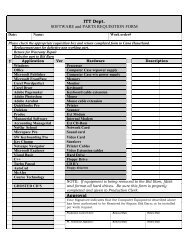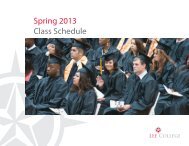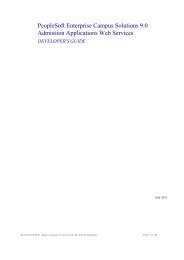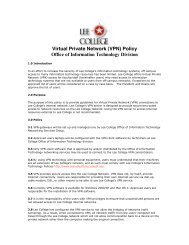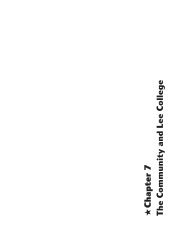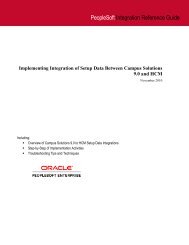Cheryl Willard - Lee College
Cheryl Willard - Lee College
Cheryl Willard - Lee College
You also want an ePaper? Increase the reach of your titles
YUMPU automatically turns print PDFs into web optimized ePapers that Google loves.
FACULTY LEARNING COMMUNITY<br />
TEACHING PORTFOLIO<br />
<strong>Cheryl</strong> <strong>Willard</strong><br />
Fall 2006
Table of Contents<br />
Page Nos.<br />
Syllabus ...................................................................................................... 1 – 4<br />
Reflective Thinking Statements ................................................................. 5 – 6<br />
Critical Thinking Concepts & Practices<br />
• Considering the Opposite Point of View ............................................. 7 – 9<br />
• Correlation ≠ Causation ....................................................................... 10 – 12<br />
• Thinking Critically with Psychological Science ................................. 13 – 17<br />
• Building Up and Applying Operant Conditioning Principles ........... 18 – 24<br />
• Building an Argument through Reasoned Judgment ........................... 25 – 27<br />
• Avoiding Assimilation Bias ................................................................. 28 – 30<br />
Active Learning Statement ............................................................................ 31<br />
• Memory ................................................................................................ 32 – 33<br />
• Simulated Experiment ............................................................................ 34<br />
• The “B” Test of Intelligence ................................................................... 35<br />
References ...................................................................................................... 36
PSYC 2301.M05 - INTRODUCTION TO PSYCHOLOGY<br />
Spring 2007<br />
Instructor: <strong>Cheryl</strong> A. <strong>Willard</strong>, Ed.S. Website: http://www.lee.edu/~cwillard/<br />
Office: Social Sciences Bldg., No. 230 Office Phone: 281-425-6370<br />
E-mail: cwillard@lee.edu<br />
Office Hours: MON/WED 4:30–5:30 p.m..,<br />
TUES/THURS 10:00 a.m.–Noon, and by appointment<br />
Division Secretary: Marian Stein Telephone: 281-425-6371 Fax: 281-425-6510<br />
Division Chair: Steve Showalter Telephone: 281-425-6372 E-mail: sshowalt@lee.edu<br />
REQUIRED MATERIALS:<br />
Textbook: Exploring Psychology, 6 th ed., Myers, David G. (2005).<br />
Website: http://www.worthpublishers.com/exploring6e/<br />
COURSE DESCRIPTION:<br />
Introduction to Psychology is a survey course of the major concepts, theories,<br />
terminology, issues, and research findings of the various sub-fields in psychology. Some of<br />
the areas that psychologists study include: cognition and learning, emotion, lifespan<br />
development, social influences, personality, psychological disorders, and the biological bases<br />
of thinking, feeling, and behaving.<br />
As the subject matter of this course is approached, special emphasis will be placed on<br />
critical thinking. Critical thinking will be discussed in more detail as the course progresses,<br />
but some of the skills involved include: making inferences based on evidence and logic;<br />
identifying underlying assumptions; analyzing both evidence and counter-evidence;<br />
examining different points of view fair-mindedly; and, being reflective about one’s own<br />
thought processes. Thus, this course involves more than memorizing facts and information.<br />
You will be asked to actually engage your mind in assessing that information.<br />
There are many benefits to be derived from well-developed critical thinking skills.<br />
Learning to become aware of tendencies to make immediate, unexamined responses to<br />
situations and to instead weigh and examine alternatives will help you to make thoughtful,<br />
well-reasoned decisions that can affect your career, your family, and your future.<br />
COURSE OBJECTIVES:<br />
1. To become knowledgeable in the basic content areas of psychology.<br />
2. To learn about the history of psychology and the major contributors to the discipline.<br />
3. To be able to distinguish between the major perspectives (biological, psychoanalytical,<br />
behavioral, cognitive, and sociocultural) as applied to human thought and behavior.<br />
4. To develop an understanding of the scientific methods used in psychological research.<br />
5. To be able to apply psychological concepts to everyday life.<br />
6. To recognize how the actions and thoughts of individuals are influenced by the social and<br />
cultural environment.<br />
7. To gain understanding of self and others.<br />
8. To develop a view of the complexity of human behavior from multiple perspectives.<br />
9. To strengthen your ability to think critically about the course material.<br />
10. Increased tolerance of ambiguity since cause-and-effect explanations of human behavior<br />
are often tentative.<br />
1
REQUIREMENTS:<br />
1. QEP Assessments. In compliance with <strong>Lee</strong> <strong>College</strong>’s Quality Enhancement Plan (QEP),<br />
pre- and post-testing of reading and critical thinking skills is required. The California<br />
Critical Thinking Skills Test (CCTST) and the Nelson Denny Reading Test are the<br />
assessments that will be used. You will be given an appointment with the testing center<br />
for their administration. If it is impossible for you to take the test at the assigned time,<br />
you will need to make arrangements with the testing center for another time and let me<br />
know what arrangements have been made. The pre-tests must be taken no later than<br />
Friday, Feb. 2 nd . The same set-up will apply to the post-tests which must be taken<br />
between Mon., April 16 th and Friday, May 4 th . These tests are required for this course<br />
and failure to take them during the specified times will result in your being withdrawn<br />
from the course. However, please be assured that your grade will in no way be<br />
affected by your scores on these tests. In addition, another short survey, called the<br />
Community <strong>College</strong> Survey of Student Engagement (CCSSE) will be administered during<br />
class sometime during the course of the semester.<br />
2. Exams: Four exams will be administered during the course, one following each unit of<br />
material. Exams will be both multiple-choice and essay, and will cover both lecture and<br />
chapter assignments. A study guide will be provided for each test for the purpose of<br />
helping to focus your attention on important concepts, terms, and theories.<br />
Students are required to take all four tests. If an emergency arises that prevents class<br />
attendance on exam day, make-up exams can only be taken the week before finals. It is<br />
the student’s responsibility to make arrangements with the instructor if an exam is missed.<br />
Failure to take an exam will result in a “0” for that particular test.<br />
3. Critical Thinking and Active Learning Exercises. Learning occurs best when you are<br />
actively engaged with the subject matter. Consequently, several critical thinking and<br />
hands-on exercises are built into the course. Some will be conducted in class and some<br />
will be take-home assignments. Points will be earned for both. Points earned for the inclass<br />
activities CANNOT BE MADE UP if you are absent or late to class. The take-home<br />
assignments must be turned in by their due dates. Late assignments will not be accepted.<br />
4. Attendance, Tardiness, and Withdrawal. Class attendance is an important part of your<br />
learning experience and is therefore expected. Research shows that one of the best<br />
predictors of grades is regular class attendance. In addition to missing out on lectures and<br />
class discussion, your grade may also be affected by excessive absences and tardies<br />
because you may miss out on active learning points which cannot be “made-up” at a later<br />
time. If you miss class, it is your responsibility to inquire about any assignments that<br />
were given on that day.<br />
If you decide to drop the course, it is your responsibility to complete a drop form and<br />
turn it in at the <strong>Lee</strong> <strong>College</strong> records office prior to the drop deadline of Thurs., April 13 th .<br />
If you simply quit coming to class and do not complete the drop form, a grade of “F” will<br />
be received. At the instructor’s discretion, you may be dropped for nonattendance after<br />
three unexcused absences. If you arrive late to class, it is your responsibility to let the<br />
instructor know at the end of class that you are present. Otherwise, you will be counted<br />
as being absent.<br />
2
5. Library Scavenger Hunt. For this assignment, you will become more familiar with the<br />
<strong>Lee</strong> <strong>College</strong> Library by locating various elements and documents. The separate “fill-inthe-blank”<br />
handout is due at the time of the first exam. These will not be returned. One<br />
point per day will be deducted from late library hunt papers.<br />
6. Academic Integrity. Honest, mature, and ethical behaviors are expected in this class.<br />
Cheating on exams, plagiarism, and other forms of academic dishonesty will not be<br />
tolerated (see the Academic Honesty Code outlined in the <strong>Lee</strong> <strong>College</strong> Catalog).<br />
GRADES:<br />
Grades will be based on a distribution of points earned for your library assignment, exams,<br />
and critical thinking/active learning exercises and assignments. The following guidelines will<br />
be used to determine your grade:<br />
90 – 100% = A; 80 – 89% = B; 70 – 79% = C; 60 – 69%= D; 0 – 59% = F<br />
Minimum passing grade will be no less than 60% of the points possible.<br />
CIVILITY IN THE CLASSROOM:<br />
It is my responsibility to ensure a civil classroom atmosphere, one in which respect<br />
among classmates is maintained. This also includes establishing an environment in which<br />
attention and energy are focused on teaching and learning. Research has shown that certain<br />
behaviors can have a detrimental effect upon learning. Please be aware of the following<br />
behaviors so you can avoid engaging in them. Also know that if you decide to engage in<br />
these behaviors, it will be my responsibility to ask you to stop:<br />
• Allowing your cell phone to ring in class<br />
• Disrupting class with distracting noises or by having private chats with classmates.<br />
• Arriving to class late or leaving early.<br />
• Packing up to go 5 minutes before the end of class.<br />
• Showing disrespect for others’ opinions.<br />
• Using tobacco products in class.<br />
Also be aware that during exams, cell phones may not be visible, and ball caps must be<br />
removed or worn backwards.<br />
3
COURSE SCHEDULE<br />
UNIT I<br />
Ch 1 - Thinking Critically with Psychological Science<br />
Ch 2 - Neuroscience and Behavior<br />
Ch 3 – The Nature and Nurture of Behavior<br />
Wed.,<br />
Ch 6 – States of Consciousness<br />
UNIT II<br />
Ch 7 – Learning<br />
Ch 8 – Memory<br />
Ch 9 – Thinking, Language, and Intelligence<br />
UNIT III<br />
Ch 4 – The Developing Person<br />
Ch 10 - Motivation<br />
Ch 15 – Social Psychology<br />
UNIT IV<br />
Ch 12 – Personality<br />
Ch 13 - Psychological Disorders<br />
Ch 14 - Therapy<br />
Target<br />
Test Date<br />
Feb. 7 th<br />
Mon.,<br />
March 19 th<br />
Wed.,<br />
April 11 th<br />
Final Exam<br />
Mon., May 7 th<br />
5:45p.m.<br />
Students with a documented disability (to include any physical, emotional, or learning<br />
disability) may arrange accommodations only through the Disability Services Office in<br />
the Counseling Center at <strong>Lee</strong> <strong>College</strong>. Your instructor will work with this office to<br />
ensure that your rights are met. The Counselor for Students with Disabilities is Dr.<br />
Rosemary Coffman and may be reached in the Counseling Center or by calling 281-425-<br />
6384 or by e-mail at rcoffman@lee.edu.<br />
4
Reflective Thinking Statement No. 1<br />
Categorical Thinking<br />
Cognitive science tells us that humans are pre-wired to attempt to make sense out of<br />
their world in order to make it more manageable and predictable (and hence, less frightening).<br />
At the same time, the world is complicated and ever-changing with new understandings<br />
replacing old, and break-through discoveries revealing facts previously unknown.<br />
Additionally, there is often not a single straight-forward causal explanation for how a<br />
particular element of the world operates. This is no less true when is comes to human<br />
behavior which is often multiply determined.<br />
While the complexity of life demands broad and diverse thought processes, the<br />
economy of the brain streamlines information so that we tend to think both categorically and<br />
in terms of our already existing beliefs about the world (Macrae & Bodenhausen, 2001).<br />
Although this strategy may have the evolutionary advantage of allowing us to quickly assess a<br />
situation, it can also have the undesirable consequences of distorting reality so that it<br />
conforms to our pre-existing schemas and explanatory categories.<br />
Several of the exercises and assignments described herein are designed to assist<br />
students in examining their automatic assumptions of causation and the kinds of inferences<br />
drawn based on immediate, unexamined reactions. The objective of these exercises is the<br />
development of a more conscious, deliberate approach to analyzing human behavior that is<br />
less dependent on the automaticity of categorical thinking. If successful, students can learn to<br />
broaden their perspectives so that their responses to situations are thoughtful and wellreasoned.<br />
Not only will this help to strengthen their academic performance, but it will also<br />
enable them to make better decisions that will influence their jobs, their relationships, their<br />
citizenship, and their future endeavors.<br />
5
Reflective Statement No. 2:<br />
Collaborative Learning<br />
A Russian psychologist, named Lev Vygotsky, is known for his work on cognitive<br />
development. His work is generally applied to the development of children but I believe<br />
aspects of his work applies equally well to college students. Vygotsky’s view is that<br />
cognitive development is facilitated by a mentor who serves as a scaffold that provides<br />
temporary structure as problem-solving skills are cultivated in the student. The mentor<br />
intervenes when necessary and withholds assistance as the student becomes more competent.<br />
Eventually, the scaffolding can be removed as the student internalizes the processes involved<br />
in accomplishing the task. Central to Vygotsky’s theory is the zone of proximal development,<br />
which is a span that begins with the student’s actual development level – with what has<br />
already been mastered. The zone ends with an upper limit of what the student is capable of.<br />
Vygotsky believed that the optimal assistance by a mentor would be that which is just slightly<br />
higher than the student’s current development level.<br />
I believe there are several implications as applied to college students. One, it seems<br />
important to build the kind of relationship with students that encourages their active<br />
participation and communication. In this way, the instructor can intervene to assist with<br />
clarity, accuracy, depth, precision, and other complexities of thought. This may be done<br />
through Socratic questioning, thus providing structure as the students’ critical thinking skills<br />
are being developed.<br />
As pertaining to Vygotsky’s concept of the zone of proximal development, students<br />
obviously have different zones. Our students vary widely, coming from diverse backgrounds<br />
with different levels of skills and abilities. Vygotsky’s approach suggests that you have to be<br />
sensitive to where each student is because learning beyond the upper limit of their zone is not<br />
possible; it’s beyond their limit. Over time, of course, the entire zone moves forward. But<br />
only if the student has had the chance to achieve the tasks within their capabilities.<br />
The fact that students’ ability levels vary can be problematic in the college classroom.<br />
Classes generally operate under the assumption that students are on the same level, and so the<br />
same requirements and standards are applied to all students. The resources are not present<br />
that would first, allow for assessments of each student’s level, and second, to tailor individual<br />
assignments to match those levels. However, it seems that varying the type and difficulty<br />
level of assignments might be a way to capture the various levels of more students, and that is<br />
what I have attempted to do. Some of my assignments show students how to build up an<br />
understanding of a complicated topic through a logical step-by-step process. Others require<br />
students to reason through and assess the strengths and weaknesses of different points of<br />
view. As instructors model critical thinking, fashion assignments which build on these skills,<br />
and foster collaborative, interactive relationships with students, perhaps their zones of<br />
proximal development will gradually move forward. That is the hope.<br />
6
Critical Thinking Concept #1:<br />
Considering the Opposite Point of View<br />
Students come to the classroom with definite opinions and theories of their own, many<br />
of which are grounded in neither adequate reasoning nor scientific understanding. Nor can it<br />
be assumed that simply presenting corrective information will be sufficient for students to be<br />
swayed. In fact, several studies have shown that people tend to cling to their beliefs despite<br />
evidence to the contrary, a phenomenon referred to as belief perseverance (Myers, 2005, p.<br />
301)<br />
A technique called “counterattitudinal advocacy” has shown some promise in reducing<br />
erroneous beliefs (Miller, Wozniak, Rust, Miller, & Slezak, 1996). This approach involves an<br />
assignment wherein students are asked to write an essay explaining why a position that is<br />
counter to their own point of view might be true. It has been suggested that the resulting<br />
attitude change can be explained by Leon Festinger’s concept of cognitive dissonance, an<br />
uncomfortable tension that results when two thoughts or cognitions are in conflict. In this<br />
case, students are espousing a belief in one direction and at the same time generating an<br />
argument in the opposite direction. People are motivated to reduce this unpleasant cognitive<br />
state and one way that this can be done is to change the original position, thus resolving the<br />
conflict.<br />
The following assignment for this critical thinking concept will help students to<br />
consider alternate points of view, giving a less biased consideration of important<br />
psychological phenomena. It will also give students the opportunity to practice making sound<br />
arguments based on reason and scientific evidence.<br />
7
Practice #1:<br />
Considering the Opposite Point of View<br />
At the beginning of the semester, students will complete a “Fact or Falsehood”<br />
questionnaire (see next page) containing items about which students often have erroneous<br />
ideas (e.g., “Advertisers are able to shape our buying habits through subliminal messages”).<br />
They will indicate whether they believe the item to be true or false and the degree to which<br />
they agree or disagree with the item on a scale from 1 to 6. Afterward, I will assess the<br />
questionnaires and make note of those items with which students’ opinions were the most<br />
incompatible with existing scientific knowledge as indicated by their ratings (e.g., Agree or<br />
Strongly Agree).<br />
In the last two weeks of the semester, after relevant content has been covered and<br />
students have been exposed to critical and scientific thinking, they will be given a take-home<br />
assignment in which they will write an essay on one of the above topics supporting a position<br />
opposite of their own. The topics will be pre-assigned to students based on their responses to<br />
the questionnaire but they will be allowed to choose from among three. According to Miller<br />
et. al. (1996), the technique is most effective if students have an element of free choice in the<br />
assignment. The instructions for writing the assignment will be as follows:<br />
Choose one of the topics below and write a persuasive essay in support of<br />
the position. Support the position with as many valid arguments as you<br />
can think of using both your textbook and other outside sources to reinforce<br />
your case. Essays should be type-written – one page in length, one-inch<br />
margins (top, bottom, right, and left), double-spaced, Times New Roman, 12-<br />
point font. Use a second page to document all of the sources that you used,<br />
including your textbook, internet sources, and other books or journals.<br />
During the last class day, I will again administer the “Fact or Falsehood” questionnaire<br />
noting any change in beliefs and paying special attention to the items for which students had<br />
written an essay. This will provide an informal assessment the effectiveness of this technique<br />
to alter students’ mistaken beliefs.<br />
8
Fact or Falsehood<br />
To the left of each item below, circle whether you believe the statement to be true or false. In the<br />
space on the right, indicate the strength of your belief according to the following scale:<br />
Strongly Mildly Mildly Strongly<br />
Disagree Disagree Disagree Agree Agree Agree<br />
1 2 3 4 5 6<br />
T F 1. Advertisers are able to shape our buying habits through subliminal<br />
messages.<br />
T F 2. Most people would do serious harm to an innocent person if<br />
instructed to do so by an authority figure.<br />
T F 3. People are LESS likely to help another person when they are alone<br />
than when other people are around.<br />
T F 4. The polygraph has proved to be extremely effective in<br />
detecting lies.<br />
_______<br />
_______<br />
_______<br />
_______<br />
T F 5. Opposites attract. _______<br />
T F 6. Homosexuality is usually not something that is freely chosen<br />
and therefore not easily changed.<br />
T F 7. Hypnosis enables people to recover accurate memories as far back<br />
as birth, a phenomenon called age regression.<br />
T F 8. Most psychologists believe that dreams provide a key to<br />
understanding our underlying inner conflicts.<br />
T F 9. Mental illness is not uncommon; in fact, about 1 in 6<br />
Americans suffer from a clinically significant mental disorder.<br />
_______<br />
_______<br />
_______<br />
_______<br />
T F 10. Spanking is one of the most effective forms of discipline. _______<br />
T F 11. Our memory works much like a video camera, accurately<br />
recording our experiences in our brain.<br />
_______<br />
T F 12. A schizophrenic is someone who has multiple personalities. _______<br />
Critical Thinking Concept<br />
9
Critical Thinking Concept #2:<br />
Correlation ≠ Causation<br />
Correlation research examines the relationship between two variables. A positive<br />
relationship exists if high scores on one variable are related to high scores on<br />
the other (or if low scores are related to low scores). An example of a positive<br />
correlation would be the amount of time spent studying and scores on an exam.<br />
A negative relationship exists if high scores on one variable are related to low<br />
scores on the other, such as the relationship between the amount of alcohol<br />
consumed and physical coordination skills.<br />
An advantage of the correlation method of research is that it allows for prediction. If<br />
there is a strong correlation between two variables, then knowing the value on one variable<br />
allows us to predict the other. I could predict, for example, that a student who seldom attends<br />
class will do poorly on an exam because there is a negative correlation between class absences<br />
and course grades. However, knowing that a relationship exists does not prove that one variable<br />
is the “cause” of the other. Correlation suggests the possibility of a cause-effect relationship, but<br />
it’s possible that other non-obvious factors may be involved. For example, a negative correlation<br />
has been demonstrated between self-esteem and depression (Myers, 2005). However, the<br />
sources and direction of causation are unknown.<br />
Depression may cause<br />
Low self-esteem may cause<br />
low self-esteem<br />
depression<br />
Self-esteem and depression may influence<br />
each other in a reciprocal fashion<br />
Brain chemistry may cause both<br />
Distressing events may cause both<br />
Depression<br />
low self-esteem<br />
and<br />
depression<br />
low self-esteem<br />
and<br />
depression<br />
low self-esteem<br />
Inferences refer to conclusions or judgments that are made about one thing based on the<br />
observations of something else (Paul & Elder, 2006). This exercise is designed to help students<br />
reason through correlation studies so that the inferences made are logical and justified by the<br />
research methodology.<br />
10
Practice #2:<br />
Correlation ≠ Causation<br />
Demonstrating that a correlation exists does not prove that changes in one variable are the causes<br />
of changes in the other. A cause-effect relationship between the two variables may or may not<br />
exist. Other factors which are undetected may be influencing both variables.<br />
For example: A study reports a positive correlation between juvenile delinquency and parental<br />
rejection.<br />
Explanation 1: Parental rejection causes juvenile delinquency.<br />
Explanation 2: Bad behavior in the juvenile causes the parents to be rejecting.<br />
Explanation 3: Poor socioeconomic living conditions generates frustration and anguish<br />
which influence both parental rejection and juvenile delinquency.<br />
For the studies described below, suggest two possible causal explanations while keeping in mind<br />
different pathways of causation:<br />
1. Studies have shown a negative correlation between depression and levels of serotonin.<br />
Explanation 1:<br />
___________________________________________________________<br />
Explanation 2: ___________________________________________________________<br />
2. A study found a negative correlation between alcohol consumption and memory.<br />
Explanation 1: ___________________________________________________________<br />
Explanation 2: ___________________________________________________________<br />
3. A positive correlation was shown to exist between caffeine consumption and level of<br />
stress.<br />
Explanation 1: ___________________________________________________________<br />
Explanation 2: ___________________________________________________________<br />
4. A college professor found a negative correlation between class absences and course<br />
grades.<br />
Explanation 1: ___________________________________________________________<br />
Explanation 2: ___________________________________________________________<br />
5. Studies show that the more psychology courses students take during their college years,<br />
the higher their scores on measures of interpersonal sensitivity (i.e., a positive<br />
correlation).<br />
Explanation 1: ___________________________________________________________<br />
Explanation 2: ___________________________________________________________<br />
11
Key for Correlation ≠ Causation<br />
Answers will vary, but here are some possible causal explanations:<br />
1. Studies have shown a negative correlation between depression and levels of serotonin.<br />
Explanation 1: Low levels of serotonin cause depression.<br />
Explanation 2: Depression causes low levels of serotonin.<br />
Explanation 3: Stressful life events influence both brain chemistry and depression.<br />
2. A study found a negative correlation between alcohol consumption and memory.<br />
Explanation 1: Alcohol causes memory impairment.<br />
Explanation 2: Drinking and partying reduces the amount of sleep one gets which is<br />
related to low scores on memory tests.<br />
3. A positive correlation was shown to exist between caffeine consumption and level of<br />
stress.<br />
Explanation 1: Daily stressors lead people to consume more caffeine.<br />
Explanation 2: Caffeine causes people to make more minor errors and thus experience<br />
more stress.<br />
Explanation 3: Number of hours spent at work in a week independently lead people to<br />
consume more caffeine and to experience more stress.<br />
4. A college professor found a negative correlation between class absences and course<br />
grades.<br />
Explanation 1: A high number of classes (and corresponding missed information) cause<br />
lower grades.<br />
Explanation 2: Students with jobs or other responsibilities find it difficult to make it to<br />
class or to find time to study.<br />
5. Studies show that the more psychology courses students take during their college years,<br />
the higher their scores on measures of interpersonal sensitivity (i.e., a positive<br />
correlation).<br />
Explanation 1: Psychology courses cause people to have greater sensitivity.<br />
Explanation 2: People who have had traumatic life experiences tend to show greater<br />
sensitivity and to take more psychology courses.<br />
Explanation 3: People with greater interpersonal sensitivity take more psychology<br />
courses.<br />
12
Critical Thinking Concept #3:<br />
Thinking Critically with Psychological Science<br />
This exercise involves the use of several elements of critical thought, including questioning<br />
one’s assumptions, making logical inferences, and using data and scientific concepts to<br />
support one’s reasoning. The exercise was located in The Critical Thinking Companion by<br />
Halonen and Gray (2001). Slight modifications were made.<br />
Without effective critical thinking abilities, we could easily fall prey to questionable<br />
claims about the causes of behavior, such as this sampling of headlines from tabloid papers over<br />
the last few years:<br />
“Wiggling Your Ears Makes You Smarter”<br />
“Woman’s Head Explodes During Psychic Trance”<br />
“Belly Button Shape Reveals Your Character”<br />
“Eating Bananas Increases Your Bust Size”<br />
Psychological reasoning is an important intellectual ability, whether we are selecting a<br />
product for purchase or exercising our citizens’ rights by deciding which candidate will get our<br />
vote. Understanding the principles of critical thinking in psychology should enable us not only<br />
to create and defend our opinions more effectively but also to challenge arguments that are<br />
invalid.<br />
The primary emphasis of this type of thinking is one question: “What’s your evidence?”<br />
Psychological research design teaches us to examine claims about behavior and to consider<br />
alternative explanations. What other variables might account for the relationship being claimed?<br />
By applying the following experiment-based principles of psychological reasoning, we can<br />
protect ourselves against invalid claims.<br />
1. Don’t expect simple cause-and-effect relationships. They rarely exist in relation to<br />
behavior, so a skeptical or disbelieving stance is generally the safest response to<br />
simplistic claims about the causes of behavior.<br />
2. Don’t settle for cause-and-effect statements without sufficient evidence. Remember that<br />
question: “What’s your evidence?” Is the evidence objective (derived from systematic,<br />
unbiased, and well-controlled observation) or subjective (influenced by personal<br />
experiences, characteristics, and biases)? Personal testimony is particularly problematic,<br />
especially when the enthusiastic advocate is being paid for it.<br />
3. Don’t confuse interpretation of behavior with behavior itself. People often embellish<br />
their observation of behavior with statements about the meaning of the behavior. They<br />
then report their conclusions about the behavior instead of describing the behavior they<br />
observed. For example, on witnessing a professor’s late arrival to class, we might leap to<br />
the conclusion that she is busy or disrespectful or scatter-brained rather than sticking to<br />
the facts. The observable behavior is arriving late to class. Invalid claims may report<br />
interpretations or judgments about a behavior rather than focusing on a description of<br />
behavior without interpretation.<br />
13
4. Don’t mistake correlation for causation. It is easy to come to the wrong conclusion<br />
about what causes behavior. Sometimes what appears to be a strong cause-effect<br />
relationship may be an illusion. For example, let’s examine the first statement in the<br />
roster of tabloid headlines – “Wiggling Your Ears Makes You Smarter.” Digging<br />
underneath this headline, you may discover that the writer swears by ear wiggling as a<br />
method of increasing intelligence. His evidence? He wiggled his ears all the way<br />
through his college admission test and his score was in a top percentile. This silly<br />
example demonstrates that the occurrence of two variables close together in time (for<br />
example, ear wiggling and intelligent performance during test taking) can sometimes be<br />
interpreted as causal. (Even smart people make this error!) Clearly, other variables could<br />
have led to the writer’s performance on his admission test.<br />
5. Do look for experimental comparisons that involve control conditions. Controlled<br />
comparison is the key to ruling out alternative explanations that make some claims<br />
implausible or unbelievable. We may never know the real cause for some effect unless<br />
we perform systematic study on the proposed relations to determine whether there is any<br />
other way to account for observed changes in behavior. Psychological research is heavily<br />
biased toward experiments in which controlled comparisons can reduce alternative<br />
explanations.<br />
6. Do examine how behaviors are defined or operationalized. Definitions can be very<br />
slippery, as anyone who has gone to a hair stylist and asked for “just a little” hair<br />
trimming knows. Precision in definitions is even more important in psychological<br />
research. Some cause-effect claims may seem very compelling until you require precise<br />
definition of the terms used in the claim.<br />
14
Practice #3:<br />
Thinking Critically with Psychological Science<br />
For each of the claims described below, decide how well each of them stands up to the principles<br />
outlined above. Identify the principle involved and give a brief statement of explanation. For<br />
example:<br />
Halloween Wisdom<br />
A psychologist strongly endorses the traditional children’s practice of trick-or-treat at<br />
Halloween. In a video produced by a leading U.S. candy company, he suggests that trick-ortreat<br />
rituals help children overcome common childhood fears. The psychologist also<br />
mentions that chocolate candies are probably the most beneficial treats to give because they<br />
contain a chemical that promotes the release of neurotransmitters involved in promoting<br />
pleasurable moods.<br />
Principle 2: Don’t settle for cause-effect statements without sufficient evidence. What is the<br />
psychologist’s evidence? Even though a person’s credentials seem impressive, we should<br />
not suspend appropriate criteria in evaluating a cause-effect claim.<br />
Principle 5: Do look for experimental comparisons that involve control conditions. Did a<br />
well-designed study with control conditions lead to these conclusions?<br />
Your Turn!<br />
The Tanned Rock Queen<br />
A famous female rock star encourages you to join a new tanning salon and shows you her tan<br />
marks to prove the salon’s effectiveness.<br />
___________________________________________________________________________<br />
___________________________________________________________________________<br />
___________________________________________________________________________<br />
The Moralizer<br />
A local politician suggests that heavy metal music is responsible for increasing violence<br />
among teenagers and proposes that all such music be banned.<br />
___________________________________________________________________________<br />
___________________________________________________________________________<br />
___________________________________________________________________________<br />
The Laundry<br />
A photogenic child wallows in a mud puddle in a TV advertisement. The smiling (and rich)<br />
Mom who wants to try out the effectiveness of her new detergent rips the child’s shirt in half<br />
and launders one half in her old detergent and the other half in the new detergent. The half<br />
laundered in the new product is substantially cleaner.<br />
___________________________________________________________________________<br />
___________________________________________________________________________<br />
___________________________________________________________________________<br />
15
The New Car<br />
A pleasant announcer promises you that your social life will have lots of pizzazz if you buy<br />
his company’s new car – the Pizzazz-mobile.<br />
___________________________________________________________________________<br />
___________________________________________________________________________<br />
___________________________________________________________________________<br />
One Bad Apple<br />
The president of the most successful company in town has developed some strong<br />
preferences in her hiring practices. She had a bad experience with a graduate of your college<br />
three years ago. As a result, the company will no longer employ anyone graduating from<br />
your college, even though the legality of this practice seems questionable.<br />
___________________________________________________________________________<br />
___________________________________________________________________________<br />
___________________________________________________________________________<br />
The Blind Date<br />
Your friend sets you up with a blind date. He describes your date as someone who has strong<br />
interests in the environment. At the start of the evening, your date proposes a walk along the<br />
beach and during that walk, picks up cans and shoves them into a backpack. You conclude<br />
that the rumored interest in environmental issues is true.<br />
___________________________________________________________________________<br />
___________________________________________________________________________<br />
___________________________________________________________________________<br />
The Burglars<br />
A recent newspaper reporter speculated that a full moon may have an enhancing effect on<br />
criminal behavior because crimes, especially breaking and entering, seem to increase<br />
dramatically when the moon is full. The reporter cited interviews with several leading<br />
mental health specialists who have noted a “full moon effect” in other areas of mental health<br />
management.<br />
___________________________________________________________________________<br />
___________________________________________________________________________<br />
___________________________________________________________________________<br />
16
Key for Thinking Critically with Psychological Science<br />
The Tanned Rock Queen<br />
Principle 2: Don’t settle for cause-effect statements without sufficient evidence.<br />
Personal testimony is not effective evidence even when it is given by someone famous.<br />
How do you know the rock star isn’t fresh from a cruise to the Caribbean?<br />
The Moralizer<br />
Principle 1: Don’t expect simple cause-effect relationships. Violence is a complicated<br />
behavior that has multiple causes.<br />
Principle 4: Don’t mistake correlation for causation. Two alternative explanations are:<br />
1) that heavy metal music reflects a violent culture rather than causing violence within<br />
the culture, and 2) that both heavy metal music and violence are caused by other<br />
variables.<br />
The Laundry<br />
Principle 5: Do look for experimental comparisons that involve control conditions.<br />
Although television Moms do demonstrate questionable reality testing, this test included<br />
good controls in design; if all conditions were equal, the experiment should provide valid<br />
evidence that the new detergent is more effective.<br />
The New Car<br />
Principle 6: Do examine how behaviors are defined or operationalized. Just what does<br />
“pizzazz” mean? How does the company operationally define the goal? Will you have<br />
more dates? More intense contacts with loan officers? More challenges to drag race?<br />
More speeding tickets?<br />
One Bad Apple<br />
Principle 2: Don’t settle for cause-effect statements without sufficient evidence.<br />
Subjective experience with one representative of a group is likely to be insufficient in<br />
making judgments about all the representatives of a group. Beware of making<br />
generalized conclusions about groups based on experience with one representative. This<br />
is sometimes referred to as the “N of 1” error, when N represents sample size.<br />
The Blind Date<br />
Principle 3: Don’t confuse interpretations of behavior with behavior itself. Recycling<br />
discarded cans on a date could represent a serious commitment to the environment, but it<br />
could also mean that your date is just broke (or cheap). Remember to distinguish actual<br />
behavior from the inferences or conclusions you draw about the behavior.<br />
Burglars<br />
Principle 4: Don’t mistake correlation for causation. Even though a “full moon effect”<br />
may be an appealing explanation for unlawful or extraordinary behavior, there is a<br />
simpler and more plausible explanation than unexplained lunar forces. A full moon may<br />
provide more light, enabling burglars to see better and to break in more easily.<br />
17
Critical Thinking Concept #4:<br />
Building Up and Applying Operant Conditioning Principles<br />
Richard Paul and Linda Elder (2006) discuss the importance of the accurate use of<br />
concepts in our reasoning. If concepts are not properly understood, then errors in reasoning<br />
come about. Operant conditioning concepts are often difficult for students to grasp. The<br />
terminology used is counter to students’ intuitive sense of these terms. It also takes practice to<br />
know how to use these concepts correctly.<br />
There will be two assignments focusing on operant conditioning. The first will help<br />
students build their understanding of operant conditioning concepts through a logical step-bystep<br />
process. It will be done individually as a homework assignment. Once the concepts are<br />
understood, they can then be applied to everyday situations, which will be the focus of the<br />
second assignment. Students will discuss their responses to this assignment in a small group<br />
which will give them another opportunity to process the principles of operant conditioning.<br />
18
Practice #4:<br />
Understanding Operant Conditioning<br />
B.F. Skinner described a type of learning called operant conditioning, the main<br />
assumption of which is that behavior is shaped by its consequences. In other words, it is the<br />
consequence that follows a behavior that will determine whether a person is likely to continue<br />
that behavior or not. Skinner identified four main types of consequences, as follows:<br />
Positive reinforcement - a stimulus that, when presented, strengthens or maintains a<br />
behavior. If a child receives an allowance for taking out the trash and continues to take out the<br />
trash (i.e., the behavior is maintained), then we know that the allowance was a positive<br />
reinforcer. With positive reinforcement, the person behaves to get something that they want.<br />
Negative reinforcement – a stimulus that, when removed, strengthens or maintains a<br />
behavior. If we take an aspirin and it removes our headache, and we continue to take aspirin<br />
when we have a headache, then we know that the headache was a negative reinforcer (i.e., a<br />
stimulus that was removed and which strengthened our behavior of taking aspirin). With<br />
negative reinforcement, the person behaves to get away from something that they don’t want.<br />
Positive punishment – a stimulus that, when presented, weakens or eliminates a<br />
behavior. A person who receives a $125 ticket for speeding and thereafter no longer speeds has<br />
been influenced by positive punishment.<br />
Negative punishment – a stimulus that, when removed, weakens or eliminates a<br />
behavior. A teenager stays out too late and her father takes away the keys to her car. If she no<br />
longer stays out past her curfew, then her behavior has been influenced by negative punishment.<br />
How to think about positive and negative. DO NOT THINK OF POSITIVE AND NEGATIVE<br />
IN TERMS OF GOOD AND BAD. That is an incorrect understanding when applied to<br />
conditioning principles. If you go to a doctor and have a test run for cancer and it comes back<br />
positive, that is not a “good” outcome because it indicates the presence of cancerous cells. It<br />
would be preferable for the test to come back negative because that would indicate the absence<br />
of cancerous cells. In the same way with operant conditioning, if a stimulus is “presented,” it is<br />
positive; and if a stimulus is “removed” or absent, it is negative.<br />
How to think about reinforcement and punishment. When trying to decide if a stimulus is a<br />
reinforcement or a punishment, always look at the effects on behavior. Reinforcement (both<br />
positive and negative) strengthens behavior, making it more likely to occur. Punishment<br />
weakens or stops a behavior.<br />
Rules for analyzing cases. The following questions will help to determine which type of<br />
consequence is being described.<br />
• What behavior in the case described was strengthened or weakened?<br />
• Was the behavior strengthened? (If yes, then the consequence involves either positive or<br />
negative reinforcement). Or, was the behavior weakened or eliminated? (If yes, then the<br />
consequence involves either positive or negative punishment).<br />
• What was the consequence that followed the behavior in the case described?<br />
• Was the consequence presented or removed? If presented, then either positive<br />
reinforcement or positive punishment is involved. If removed, then either negative<br />
reinforcement or negative punishment is involved.<br />
19
Read each of the following scenarios and, while referring to the above rules for analyzing the<br />
cases, answer the related questions.<br />
Example<br />
Billy likes to camp out in the backyard. He camped out on every Friday during the month of<br />
June. The last time he camped out, some older kids snuck up to his tent while he was sleeping<br />
and threw a bucket of cold water on him. Billy has not camped out for three weeks.<br />
1. What behavior was changed? Camping out<br />
2. Was the behavior strengthened or weakened? Weakened<br />
3. What was the consequence of the behavior? Cold water being thrown on him<br />
4. Was the consequence presented or removed? Presented<br />
5. This is an example of: Positive punishment<br />
Your Turn!<br />
A. Your spouse withdraws attention from you each time you begin criticizing his/her<br />
cooking. Eventually, you stop criticizing your spouse’s cooking.<br />
1. What behavior changed? _____________________________________________<br />
2. Was the behavior strengthened or weakened? _____________________________<br />
3. What was the consequence of the behavior? ______________________________<br />
4. Was the consequence presented or removed? _____________________________<br />
5. This is an example of: _______________________________________________<br />
B. Every time Madge raises her hand in class she is called on. She raised her hand 3 times<br />
during the first class, 3 times in the second, and 4 times during the last class.<br />
1. What behavior changed? _____________________________________________<br />
2. Was the behavior strengthened or weakened? _____________________________<br />
3. What was the consequence of the behavior? ______________________________<br />
4. Was the consequence presented or removed? _____________________________<br />
5. This is an example of: _______________________________________________<br />
20
C. Frank, an air traffic controller, has learned that running after work reduces his level<br />
of stress. He now runs two mile every day.<br />
1. What behavior changed? _____________________________________________<br />
2. Was the behavior strengthened or weakened? _____________________________<br />
3. What was the consequence of the behavior? ______________________________<br />
4. Was the consequence presented or removed? _____________________________<br />
5. This is an example of: _______________________________________________<br />
D. Peter’s teacher refused to let him go outside during recess because of his constant<br />
intrusions into his classmates conversations. Peter is now quiet when others are<br />
talking.<br />
1. What behavior changed? _____________________________________________<br />
2. Was the behavior strengthened or weakened? _____________________________<br />
3. What was the consequence of the behavior? ______________________________<br />
4. Was the consequence presented or removed? _____________________________<br />
5. This is an example of: _______________________________________________<br />
E. Janette, your teenage daughter, was ridiculed at school for wearing a particular style<br />
of shirt. Now she no longer wears that style of shirt at school.<br />
1. What behavior changed? _____________________________________________<br />
2. Was the behavior strengthened or weakened? _____________________________<br />
3. What was the consequence of the behavior? ______________________________<br />
4. Was the consequence presented or removed? _____________________________<br />
5. This is an example of: _______________________________________________<br />
F. Your car has a red flashing light that blinks annoyingly if you start the car without<br />
buckling your seat belt. To avoid these annoying lights, you now buckle your seat belt<br />
when you first get into your car.<br />
1. What behavior changed? _____________________________________________<br />
2. Was the behavior strengthened or weakened? _____________________________<br />
3. What was the consequence of the behavior? ______________________________<br />
4. Was the consequence presented or removed? _____________________________<br />
5. This is an example of: _______________________________________________<br />
21
Practice #5:<br />
Applying Operant Conditioning Principles<br />
Answer these questions individually. Afterward, compare and discuss your individual answers<br />
with group members.<br />
1. Suppose your boyfriend/girlfriend has the annoying habit of chewing his/her food with<br />
his/her mouth open. Using operant conditioning principles, how might you help change that<br />
behavior?<br />
2. You have a history of neglecting your homework for parties with your friends. As a result,<br />
your grades are really suffering. You want to change your behavior. Using operant<br />
conditioning principles, how can you help yourself study more and party less?<br />
22
Key for Understanding Operant Conditioning<br />
A. Your spouse withdraws attention from you each time you begin criticizing his/her<br />
cooking. Eventually, you stop criticizing your spouse’s cooking.<br />
1. What behavior changed? Criticizing spouse’s cooking<br />
2. Was the behavior strengthened or weakened? Weakened<br />
3. What was the consequence of the behavior? Spouse withdraws attention<br />
4. Was the consequence presented or removed? Attention is removed<br />
5. This is an example of: Negative punishment<br />
B. Every time Madge raises her had in class she is called on. She raised her hand 3 times<br />
during the first class, 3 times in the second, and 4 times during the last class.<br />
1. What behavior changed? Raising hand<br />
2. Was the behavior strengthened or weakened? Strengthened<br />
3. What was the consequence of the behavior? She is called on<br />
4. Was the consequence presented or removed? Attention is presented<br />
5. This is an example of: Positive reinforcement<br />
C. Frank, an air traffic controller, has learned that running after work reduces his level<br />
of stress. He now runs two mile every day.<br />
1. What behavior changed? Running<br />
2. Was the behavior strengthened or weakened? Strengthened<br />
3. What was the consequence of the behavior? Reduces level of stress<br />
4. Was the consequence presented or removed? Stress is removed<br />
5. This is an example of: Negative reinforcement<br />
D. Peter’s teacher refused to let him go outside during recess because of his constant<br />
intrusions into his classmates conversations. Peter is now quiet when others are<br />
talking.<br />
1. What behavior changed? Intrusions into conversations<br />
2. Was the behavior strengthened or weakened? Weakened<br />
3. What was the consequence of the behavior? Can’t go outside<br />
4. Was the consequence presented or removed? Outdoor activity was removed<br />
5. This is an example of: Negative punishment<br />
E. Janette, your teenage daughter, was ridiculed at school for wearing a particular style<br />
of shirt. Now she no longer wears that style of shirt at school.<br />
1. What behavior changed? Wearing a certain shirt<br />
2. Was the behavior strengthened or weakened? Weakened<br />
3. What was the consequence of the behavior? Being ridiculed<br />
4. Was the consequence presented or removed? Presented<br />
5. This is an example of: Positive punishment<br />
23
F. Your car has a red flashing light that blinks annoyingly if you start the car without<br />
buckling your seat belt. To avoid these annoying lights, you now buckle your seat belt<br />
when you first get into your car.<br />
1. What behavior changed? Buckling seat belt<br />
2. Was the behavior strengthened or weakened? Strengthened<br />
3. What was the consequence of the behavior? Annoying lights are avoided<br />
4. Was the consequence presented or removed? Removed<br />
5. This is an example of: Negative reinforcement<br />
24
Critical Thinking Concept #5:<br />
Building an Argument through Reasoned Judgment<br />
Abraham Maslow, a humanistic psychologist, developed a theory of human motivation<br />
based on needs. He arranged these needs into a hierarchy according to their strength. From<br />
strongest to weakest, the needs include: physiological needs, safety needs, belongingness and<br />
love needs, esteem needs, and self-actualization needs.<br />
Maslow, who did much of his work in the 1960’s and 70’s, believed that thus far,<br />
psychology had focused too much on abnormality and emotional disturbance at the expense of<br />
more positive human qualities. He also had great admiration for two individuals that he believed<br />
possessed many virtuous qualities, psychologist, Max Wertheimer, and anthropologist, Ruth<br />
Benedict (Levy, 1997). After learning that Wertheimer and Benedict shared many traits in<br />
common, Maslow went on a quest to seek out others with similar attributes. He then developed a<br />
profile identifying the characteristics of what he considered to be healthy, fully-functioning<br />
human beings, which he referred to as self-actualizers.<br />
In developing his theory, Maslow did not systematically collect data and analyze it<br />
scientifically. One of the main criticisms of his theory is that the criteria he used for choosing<br />
self-actualizers were based on his own subjective values of the qualities he admired in people<br />
rather than being based on objective standards.<br />
One of my concerns about the way in which students reason is that they sometimes base<br />
their opinions on the way they think that people should operate instead of using facts and logic to<br />
build their arguments. It is true that, in psychology, not all questions can be answered by known<br />
facts because in many cases, the jury is still out. Single causes and simple facts are rarely<br />
sufficient in explaining complex human behavior. However, Elder and Paul (1997) point out that<br />
judgments about phenomena are not limited to just facts and opinions. They offer a third<br />
category, reasoned judgment, which is based on relevant evidence, sound reasoning, and<br />
consideration of multiple points of view when interpreting the facts.<br />
The following assignment is designed to assist students in using reasoned judgment to<br />
build an argument about one aspect of Maslow’s theory. It requires providing reasons, both for<br />
and against, a position as well as rating the strength of those reasons, showing that not all reasons<br />
are equally good. Students will additionally draw a conclusion based on their analyses of the<br />
question.<br />
25
Practice #6:<br />
Building an Argument through Reasoned Judgment<br />
Psychologist, Abraham Maslow included in his hierarchy of needs love and belonging. Do you<br />
agree that people need to have affectionate and intimate relationships with other people?<br />
1. Give three reasons that support this conclusion.<br />
a)<br />
b)<br />
c)<br />
2. Rate each reason as weak, moderate, strong, or very strong.<br />
Rating for a:<br />
Rating for b:<br />
Rating for c:<br />
3. Give three counterarguments against this conclusion.<br />
a)<br />
b)<br />
c)<br />
4. Rate each counterargument as weak, moderate, strong, or very strong.<br />
Rating for a:<br />
Rating for b:<br />
Rating for c:<br />
5. List any qualifiers (limitations on the reasons for or against – for example some evidence<br />
may be restricted to early childhood).<br />
26
6. What is your conclusion? Are your reasons and counterarguments directly related to your<br />
conclusion? Explain.<br />
7. What is the overall strength of your argument: weak, moderate, strong, or very strong.<br />
27
Critical Thinking Concept #6:<br />
Avoiding Assimilation Bias<br />
Schemas are perceptual frameworks, or categories, that help us to keep our knowledge<br />
about the world organized. Psychologist, Jean Piaget, suggested that two complimentary<br />
processes are at work as we form various schemata: assimilation, which is fitting new<br />
information in to an already existing schema; and, accommodation, which is changing or<br />
revising our schemas in the face of new evidence.<br />
Assimilation is necessary because it allows us to catalog and make connections between<br />
what would otherwise be an overwhelming amount of information. However, we sometimes<br />
encounter experiences that don’t fit our existing schemas. In such cases, if we would put aside<br />
our preconceived notions and make the necessary accommodations in our schemas in order to<br />
allow for a correction of the facts, we would be in good shape. This is what good scientists do.<br />
If a theory does not adequately explain observed phenomena, they will change their theory to fit<br />
the facts (rather than interpreting the facts to fit the theory).<br />
So, are people in general good scientists in this respect? The research suggests not.<br />
Studies show that people tend to distort, overlook, or discard information that is incongruent with<br />
their schemas, exhibiting a bias in the direction of assimilation rather than resolving the<br />
discrepancy through accommodation (Levy, 2003).<br />
Psychotherapists often identify themselves as being associated with a particular<br />
theoretical orientation which guides their understanding and treatment of their clients. These<br />
theoretical lenses can produce the same kinds of cognitive distortions and selective<br />
interpretations as any other schemas.<br />
The assignment which follows will give students some practice with changing schematic<br />
lenses, thus providing the opportunity for a more balanced and less biased approach for<br />
understanding the complexity of human behavior.<br />
28
Practice #7:<br />
Avoiding Assimilation Bias<br />
Imagine that you are a practicing therapist and a client visits your office with concerns about<br />
feeling depressed. For each of the theoretical orientations below, briefly describe how that<br />
perspective would explain the cause of the concern, what approaches to treatment would be used,<br />
and some of the advantages and disadvantages of using that approach.<br />
For Example, Psychoanalysis<br />
CAUSE: The cause of the depression would be traced back to early losses and childhood<br />
fixations, and also unconscious conflicts that continue to influence adult decisions.<br />
TREATMENT: Treatment would consist of techniques that would bring this unconscious<br />
material to the surface of consciousness, including free association, dream interpretation,<br />
analysis of resistance, and analysis of transference.<br />
ADVANTAGES: Having greater control over one’s life by increasing self-awareness and<br />
insight into problems.<br />
DISADVANTAGES: Length of time and expense of treatment; also, the possibility of an<br />
anti-female bias.<br />
Behavior Therapy<br />
CAUSE:___________________________________________________________________<br />
__________________________________________________________________________<br />
TREATMENT:______________________________________________________________<br />
__________________________________________________________________________<br />
ADVANTAGES:____________________________________________________________<br />
__________________________________________________________________________<br />
DISADVANTAGES:_________________________________________________________<br />
___________________________________________________________________________<br />
(Continued on next page)<br />
29
Cognitive Therapy<br />
CAUSE:___________________________________________________________________<br />
__________________________________________________________________________<br />
TREATMENT:______________________________________________________________<br />
__________________________________________________________________________<br />
ADVANTAGES:____________________________________________________________<br />
__________________________________________________________________________<br />
DISADVANTAGES:_________________________________________________________<br />
___________________________________________________________________________<br />
Person-Centered Therapy<br />
CAUSE:___________________________________________________________________<br />
__________________________________________________________________________<br />
TREATMENT:______________________________________________________________<br />
__________________________________________________________________________<br />
ADVANTAGES:____________________________________________________________<br />
__________________________________________________________________________<br />
DISADVANTAGES:_________________________________________________________<br />
___________________________________________________________________________<br />
Drug Therapy<br />
CAUSE:___________________________________________________________________<br />
__________________________________________________________________________<br />
TREATMENT:______________________________________________________________<br />
__________________________________________________________________________<br />
ADVANTAGES:____________________________________________________________<br />
__________________________________________________________________________<br />
DISADVANTAGES:_________________________________________________________<br />
___________________________________________________________________________<br />
This assignment was adapted from Levy (2003) and Halonen & Gray (2001).<br />
30
Active Learning Statement<br />
After the nightmare that was my first semester of teaching, which was strictly contentoriented,<br />
I quickly adopted an active learning approach in the classroom where students are<br />
doing more than listening to me lecture. Lectures continue to be an important component of my<br />
courses, but in addition, on most days students are required to interact in some say with the<br />
topics of the lectures.<br />
According to Bonwell and Eison (1991), course content is learned equally well through<br />
lecturing and active learning strategies. However, active learning was reported to be more<br />
effective than lecture in promoting thinking and writing skills. Moreover, I know from my own<br />
students’ evaluations and their participation in class that they enjoy the active learning exercises<br />
and find them to be helpful in processing the concepts that they are learning.<br />
Following are a few of the active learning strategies that have been well-received by<br />
students.<br />
31
Practice #8:<br />
Memory<br />
When discussing memory, I usually include about three short hands-on demonstrations, such as<br />
the following:<br />
• Depth of processing versus shallow processing of material is shown by giving students a list<br />
of words with some directions at the top. This list of words is the same but there are two<br />
different sets of directions. The directions for one half of the class (side A) instructs students<br />
to rate the pleasantness of the words on a scale from 1 to 5. The directions for the other half<br />
of the room (side B) instructs students to count the number of letters each word contains.<br />
Students are unaware of the different sets of instructions and are asked to turn their lists over<br />
when finished. I briefly distract students from the list while I talk about other aspects of<br />
memory. After a couple of minutes, I ask students to write down as many of the words from<br />
the list that they can remember. They then count the number of words recalled and I write<br />
these numbers on the board, first asking side A. I then draw a line on the board to separate<br />
these scores from the scores for side B and I make a prediction based on what I know about<br />
how memory works. The prediction stated is that “this half of the room [motioning to side A]<br />
was able to remember more words than this half of the room [motioning to side B]. I then<br />
proceed to ask the side B students how many words they were able to recall and I write these<br />
numbers on the board on the other side of the line.<br />
This exercise has never failed and students are always amazed when one half of the class<br />
remembers far more words than the other half. The discussion which follows focuses on why<br />
this transpired and the fact that side A had to process the words at a deeper level than did side<br />
B. This is because they had to think about the meaning of the words before they could rate<br />
their pleasantness, whereas side B only had to engage in the mindless activity of counting the<br />
number of letters the words contained. The importance of analyzing and understanding the<br />
meaning of concepts (referred to as “elaborative rehearsal”) in order to encode them at a<br />
deeper level in memory (as opposed to mindlessly memorizing definitions or only skimming<br />
material) is then discussed. Students are asked their ideas about ways in which they can<br />
engage in elaborative rehearsal. Many of the hands-on activities described herein are, in fact,<br />
such methods.<br />
• The serial position effect is the tendency to remember more items from the beginning and end<br />
of a list and fewer items from the middle. This is demonstrated by simply reading a list of<br />
words to students and then asking them to write down all the words they remember. The<br />
words remembered tends to fit the pattern dictated by the serial position effect. The ensuing<br />
class discussion is focused on the cognitive processes involved in why this pattern occurs.<br />
32
• To demonstrate the capacity of short term memory and how it is measured, I read an<br />
increasingly long series of digits to the class, such as the those listed below:<br />
7<br />
92<br />
783<br />
5697<br />
43821<br />
531684<br />
8695137<br />
71938426<br />
152846732<br />
9437216985<br />
37148913246<br />
After each series that is read, students write down as many numbers that they can remember<br />
in the correct order. Usually, between 5 and 9 digits can be recalled. This exercise brings<br />
home the point that the capacity of short term memory for most people is 7±2 items.<br />
33
Practice #9:<br />
Simulated Experiment<br />
For this activity, an experiment is simulated in the classroom. I ask for a volunteer who<br />
is willing to balance a bottle on the forefinger of both their right and left hands and to spell<br />
words at the same time. I ask the volunteer to step out of the room while I state the hypothesis<br />
that “Balancing durations will shorten more in the right hand than the left with the introduction<br />
of a verbal task.”<br />
In this type of research design, the subject serves as his/her own control. There is first a<br />
silent condition when the student just balances the bottle without spelling words. The student is<br />
timed and baseline balancing durations are established and recorded for both the right and left<br />
hands, one hand at a time. The student then balances the bottle again, separately, in both the<br />
right and left hands while words are pronounced for her/him to spell. The entire sequence is then<br />
repeated again.<br />
While I average the scores and calculate differences to determine whether or not the<br />
hypothesis was confirmed, the students respond independently in writing to the following<br />
questions:<br />
• Why does the hypothesis make sense? [At this point, we have talked about both<br />
research methods and structures and functions of the brain, including cross laterality<br />
(the fact that the left hemisphere of the brain controls the right side of the body and<br />
the right hemisphere controls the left side of the body), and the language centers<br />
being located in the left hemisphere. When the volunteer is spelling words and<br />
balancing at the same time in his/her left hand, the right hemisphere is simply doing<br />
the balancing. However, when the volunteer is spelling words and balancing at the<br />
same time in his/her right hand, the left hemisphere is both balancing and has the<br />
added burden of the verbal task, creating greater neural interference with balancing in<br />
the right hand].<br />
• What was the independent variable? [The verbal task]<br />
• What was the dependent variable? [Balancing durations]<br />
• If this were an actual experiment, what extraneous variables would have to be<br />
controlled? [There are many, some of which include: sample size, noise and other<br />
distractions, and difficulty level of the words]<br />
34
Practice #10:<br />
The “B” Test of Intelligence<br />
The “B” test of intelligence is used as a stimulus for discussing test construction and the<br />
criteria for determining the quality of a test, namely, standardization, reliability, and validity. In<br />
addition, it demonstrates the method of correlation which is discussed in a previous class.<br />
I inform students that I have written an intelligence test and instruct them to take out a<br />
piece of scratch paper and to get ready to write. I then say to students, “When I say go, with<br />
your non-dominate hand, write the capital letter “B” as may times as you can. Go.” Students are<br />
given 30 seconds to write the letter “B.”<br />
When asked, students are not convinced that this is a good measure of intelligence and<br />
discussion is focused on why not and what would be needed for it to “measure up.” I point out<br />
that I think it’s a reliability test. To demonstrate test-retest reliability, I give students the same<br />
instructions to write the capital letter “B” with their non-dominant hand for the same length of<br />
time. I then put students’ sets of test scores on the board so that they can see the similarity of the<br />
scores for each administration of the test. Additionally, I show them the actual correlation<br />
between the scores that I have calculated for another class, which is usually greater than r =<br />
+.85, showing high reliability.<br />
When asked, students are still not convinced of the worthiness of the test even if it is<br />
reliable. Through prompts and questions, the focus of discussion turns to the tests lack of<br />
standardization procedures and its failure to meet the criterion of validity (unless intelligence is<br />
defined in terms of ambidexterity which is probably what the test actually measures).<br />
35
References<br />
Bonwell, C.C., & Eison, J.A. (1991). Active learning: Creating excitement in the classroom.<br />
(ERIC Document Reproduction Service No. ED340272)<br />
Elder, L., & Paul, R. (1997). Critical thinking: Crucial distinctions for questioning. Journal of<br />
Developmental Education, 26 (2), 34-35. (ERIC Document Reproduction Service No.<br />
EJ582341)<br />
Halonen, J., & Gray, C. (2001). The critical thinking companion for introductory psychology<br />
(2 nd ed.). New York: Worth.<br />
Levy, D.A. (1997). Tools of critical thinking: Metathoughts for psychology. Long Grove, IL:<br />
Waveland Press.<br />
Macrae, C.N., & Bodenhausen, G.V. (2001). Social cognition: Categorical person perception.<br />
British Journal of Psychology, 92, 239-255.<br />
Miller, R.L., Wozniak, W.J., Rust, M.R., Miller, B.R., & Slezak, J. (1996). Counterattitudinal<br />
advocacy as a means of enhancing instructional effectiveness: How to teach students what<br />
they do not want to know. Teaching of Psychology, 4, 215-219.<br />
Myers, D.G. (2005). Exploring Psychology (6 th ed.). New York: Worth.<br />
Paul, R. & Elder, L. (2006). Critical thinking: Learning the tools the best thinkers use. New<br />
Jersey: Pearson Prentice Hall.<br />
36


